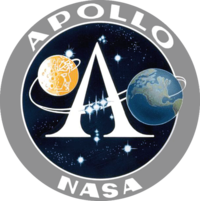AS-101
| Mission Insignia | |
|---|---|

| |
| Mission Statistics | |
| Mission Name: | A-101 (Saturn-Apollo 6) |
| Call Sign: | A-101 |
| Launch: | May 28, 1964 17:07:00 UTC Complex 37B |
| Reentry: | June 2, 1964 ~01:00:00 UTC |
| Duration: | ~3 days 8 hours |
| Number of Orbits: |
54 |
| Apogee: | 127 mi (204 km) |
| Perigee: | 111 mi (179 km) |
| Period: | 88.5 min |
| Inclination | 31.8° |
| Distance Traveled: |
1,357,466 mi (2,184,630 km) |
| Apogee Mass: | 38,900 lb (17,650 kg) |
| A-101 (SA-6) | |
A-101[1], also SA-6[2] was the first Saturn rocket launch to carry a Boilerplate Apollo spacecraft in 1964.
Boilerplate
The first five launches of the Saturn I had carried Jupiter-C nosecone that were a proven design allowing engineers to focus on the rocket. However, in order to get to the Moon, it had to be shown that the rocket could actually launch the Apollo spacecraft shape. Therefore, on A-101 the rocket carried a boilerplate spacecraft and a dummy Launch Escape System(LES). The Boilerplate BP-13 duplicated the size, weight, shape, and center of gravity of a manned Apollo command module.
This allowed it to be instrumented with 116 measuring devices so that engineers could see the strain, pressure, and acceleration experienced by the spacecraft, which they hoped would confirm their calculations.
Flight

It took three attempts to get the rocket off the pad. The first launch attempt was scrubbed after the liquid oxygen damaged a wire mesh screen during a test, causing fuel contamination. The second attempt was scrubbed after the rocket's guidance system overheated when a compressor failed in the air conditioning.
It finally lifted off on 28 May from LC-37B. There had been several delays during the count as liquid oxygen vapors obscured an optical window in the SA-6's instrument unit, so that a ground-based theodolite could not see it. This theodolite was needed for launch to proceed. In the end this requirement was removed from the computer by engineers to allow the launch to proceed as it was not critical. The mission used Apollo Boilerplate BP-13.
The ascent was normal up to 76.9 seconds after launch when engine number eight shut off early. This was not planned as on SA-4 but, pleasingly for engineers, the rocket compensated perfectly and burned the first stage for 2.7 more seconds than planned. The first stage separated and the second stage ignited. Ten seconds later the LES was jettisoned as planned (any explosion would not be catastrophic to need its ability to pull the spacecraft away at high speed). Also jettisoned from the first stage were eight film cameras that observed separation of the stages.
The second stage cut off at 624.5 seconds after launch (1.26 seconds earlier than predicted), with the stage and boilerplate in a 182 km by 227 km orbit. It continued to transmit data for four orbits when the batteries failed. Both stayed in orbit for 54 orbits, re-entering the atmosphere east of Canton Island in the Pacific Ocean on June 1.
Engine failure cause
Engineers were quick to find the cause of the failure of engine number eight. The teeth on one of the gears in the turbopump were stripped off. This did not cause any delays in the next launches as engineers had already decided that the gear design was inferior and were planning to change it for the next launch. This was the only problem encountered with an H-1 engine during a flight.

